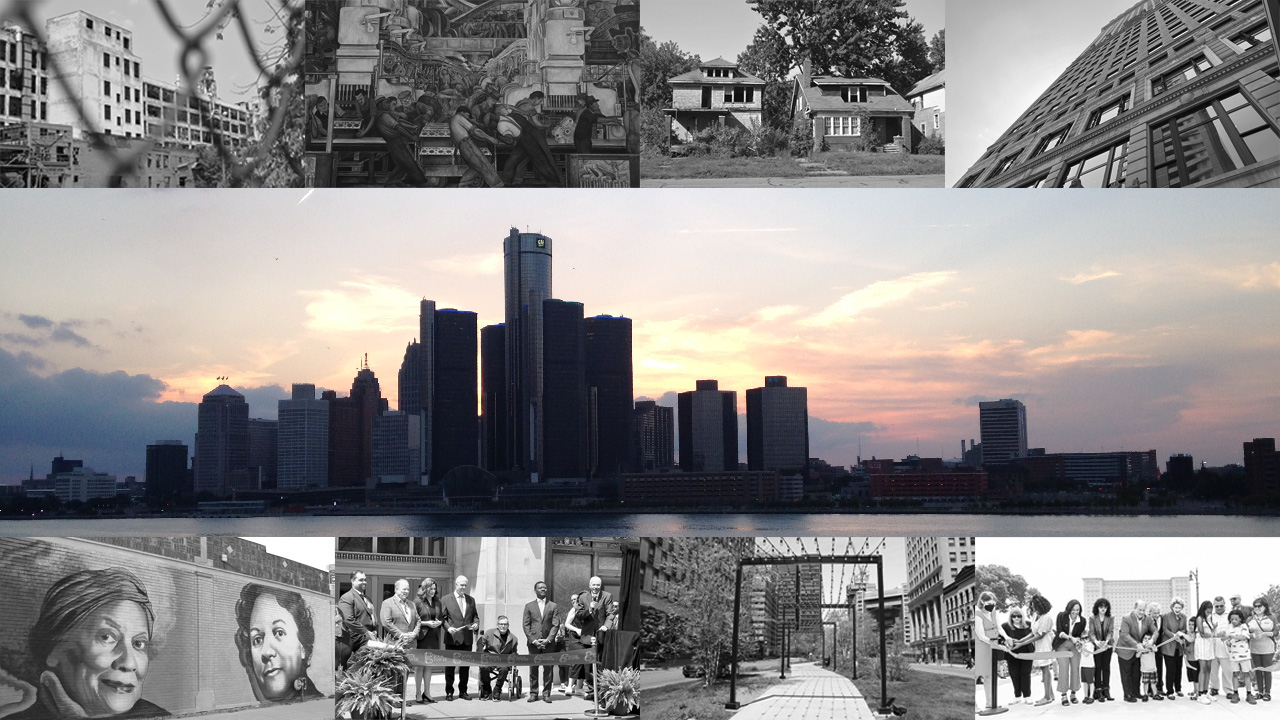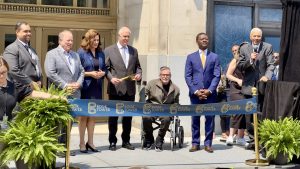Reflecting on Detroit’s bankruptcy 10 years later
The Motor City’s made significant progress in the past decade. But it still faces some daunting potholes on the road to recovery.

It’s been 10 years since the city of Detroit, drowning in roughly $18 billion in debt, filed for Chapter 9 bankruptcy protection. It was the largest municipality in the country to ever do so.
The Motor City’s made significant progress in the past decade. But it still faces some daunting potholes on the road to recovery.
The comeback
It was all sunshine and warm smiles at a recent ribbon-cutting for Detroit’s refurbished Book Tower and Book Building. The Italian Renaissance-style structures, abandoned since 2009, had been transformed into hotel rooms, apartments and shops.
A group of dignitaries were greeting the opening, led by the project’s developer, the wealthiest person in Michigan, billionaire businessman Dan Gilbert. He delivered what’s become a Motor City mantra: The renovation is one more sign that Detroit is coming back.
“Our goal is to provide the spark that will ignite other businesses, both small and large, as well as developers to get involved, attracting further investment and talent to come here and be part of this,” Gilbert said.

He’d moved his corporate headquarters to the city a few years before Detroit filed for bankruptcy in 2013. And after Detroit’s exit from Chapter 9, having shed about $7 billion dollars in debt, Gilbert and others began pouring new investment into the city.
It was especially apparent in the downtown area, which sprouted numerous trendy restaurants and upscale apartments. It amazed even the most jaded of Detroit natives, like rock star Alice Cooper.
“You were terrified to go to downtown Detroit before. Now it’s the coolest place around.” – Detroit native Alice Cooper
During a visit a few months before the pandemic erupted, Cooper noted that the previously barren and boarded-up center of the city used to resemble one of his ghoulish stage shows.
“You were terrified to go to downtown Detroit before. Now it’s the coolest place around,” Cooper said. “I kind of went yeah, downtown Detroit needs a shot in the butt.”
A stronger financial footing
Decades of government mismanagement and population decline drove Detroit to the financial brink. Even when the city emerged from bankruptcy, the state of Michigan still maintained oversight of Detroit’s monetary policy, at least until the mayor and City Council produced three straight balanced budgets.
Now Detroit has a budget surplus.
And despite the onset of COVID-19 forcing some restaurants to close and leaving office buildings vacant as employees worked from home, Detroit Mayor Mike Duggan says the city has no need to use money like federal pandemic relief funds to plug any deficits.
“Which means we can take the American Rescue Plan money and use it to build affordable housing, use it to build parks, use it to upgrade our resident’s skills. And Wall Street just upgraded our credit rating again,” Duggan says.

Agencies place Detroit just a shade below investment-grade status. Analysts like S&P Global Rating’s Randy Layman praise the city’s efforts to erase thousands of blighted buildings dotting Detroit’s neighborhoods. City officials just issued $100 million in bonds, most targeted at rehabilitating or demolishing abandoned houses.
But Layman cautions that Detroit remains very reliant on the shifting fortunes of its manufacturing base to provide any long-term economic growth.
“There’s still high poverty rates and low income in the city. That just creates practical and political challenges to raising revenue,” Layman says.
Waiting for prosperity beyond downtown
The disparity between Detroit’s flourishing downtown and impoverished neighborhoods still fuels discontent in the Motor City.
Detroit’s launched dozens of programs to help beautify some blighted areas away from the city’s central core. And city officials are pushing to attract new homeowners and renovate existing houses, hoping to increase both tax revenue and property values.
But some Detroiters say they wonder if the city worries as much about those who are already living here.
Long-time resident Duane Johnson says he watched the city sell vacant properties at cut-rate prices, but it did not help either him or others he knows who stayed in Detroit through the bankruptcy process.
“It’s like a curse,” Johnson says. “Rent goes up. They are developing those new apartments or rehabbing that new house for people who make the higher income. And it’s pushing people out.”
Fears over crime also drive people to reconsider remaining in Detroit. The city repaired thousands of broken streetlights and improved slow police and emergency service response times after the bankruptcy. Yet Detroit continues to have one of the highest per capita violent crime rates in the country.
“In the inner city they react to crime. But in downtown their job is to prevent it from happening in the first place.” – Detroit resident Duane Johnson
Johnson notes there’s a very visible police and private security presence downtown. But he says he can’t feel that on his block.
“In the inner city they react to crime. So after you are victimized is when they show up. But in downtown their job is to prevent it from happening in the first place. So that’s the difference,” he says.
Surviving pension cuts
The bankruptcy is still impacting one of Detroit’s major creditors – city government retirees.
A judge approved cuts to retirees pensions as part of the effort to eliminate debt. That meant at least a 4.5% reduction in pension payments for those in the General Retirement System, which was separate from police and fire department retirees.
Bankruptcy attorneys called it a financial “haircut,” one that could have been much more severe if state officials had not reached a deal with foundations and private donors to fund part of the pensions for a decade. The so-called “grand bargain” agreement was designed to keep the city from covering its debt by selling valuable works from the Detroit Institute of Arts.
It’s not something retirees like former city administrator Cecily McClellan remember fondly.
“We call the ‘grand bargain’ grand theft,” she says.
Detroit’s ready to resume making the pension payments out of its own budget, having set aside hundreds of millions of dollars over the past 10 years to help cover the cost. But McClellan says retirees like her are already dealing with something they never budgeted for.
“They snuck up on us. They charged us interest on the money that was being clawed back.” – Detroit city retiree Cecily McClellan
She lost thousands of dollars earned from a city annuity fund when bankruptcy attorneys decided it had paid out excessive interest and demanded it back.
Some retirees returned the money in a lump sum. Others, like McClellan, decided to make monthly payments.
“Then they snuck up on us. They charged us interest on the money that was being clawed back. So now it’s 10 years into the plan and we still owe over two-thirds of what we owed originally.”
Other retirees found they had too little money after bankruptcy to stay retired.
Those in the Police and Fire Retirement System were spared big pension cuts. But the bankruptcy reduced their cost-of-living increases. And former Detroit fire battalion chief George Orzech, who bargained on behalf of the pension system during the Chapter 9 process, says uniformed city workers effectively lost most of their health care coverage.
“I got blown out of a building. Couldn’t walk for 100 days. Who’s gonna pay for that?” – Retired Detroit firefighter George Orzech
Orzech, who had four brothers also work in Detroit’s fire department, says those who retired without being old enough to qualify for Medicare, faced some tough decisions.
“I mean I’ve been injured. When I got hired in ’77 I got blown out of a building looking for a babysitter, for God’s sake. Couldn’t walk for 100 days. Who’s gonna pay for that?”
Orzech says his wife also worked at the time, with a relatively small amount of health care coverage that helped see him through until he was eligible for Medicare at age 65.
But he says other former firefighting colleagues, including some of his siblings, weren’t as fortunate.
Orzech notes that he’s worked construction jobs on the side all of his life. But he says other retirees are doing it now to survive.
Police and fire department uniformed workers were not allowed to pay into Social Security. Instead, Orzech says, they were told they were paying into a pension that would provide them a similar economic security blanket.
That is, he says, until the advent of Detroit’s bankruptcy.
“There’s not a day that doesn’t go by I don’t think about it. But it’s 10 years ago now. I was able to at least come away with a pension and I’m walking and fairly healthy. But there’s a lot of people that aren’t like that,” Orzech says.
The Michigan legislature recently appropriated funding to help beef-up the small amount of health care coverage Detroit police and fire retirees do receive. And Detroit Mayor Mike Duggan has talked about negotiating larger pension payments for current and retired city workers, once the bankruptcy’s decade-long prohibition against collective bargaining ends next year.
The financial health of the Motor City itself continues to improve as it steers away from the economic scrap heap it seemed headed towards before bankruptcy.
It just remains to be seen how many Detroiters, past, present and future, come along for the ride.
Trusted, accurate, up-to-date.
WDET strives to make our journalism accessible to everyone. As a public media institution, we maintain our journalistic integrity through independent support from readers like you. If you value WDET as your source of news, music and conversation, please make a gift today.

